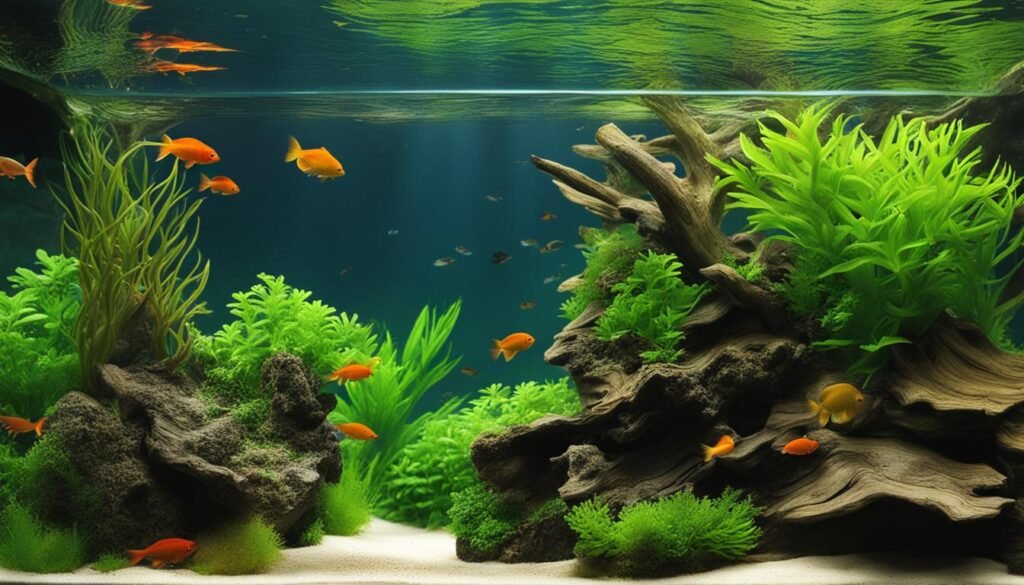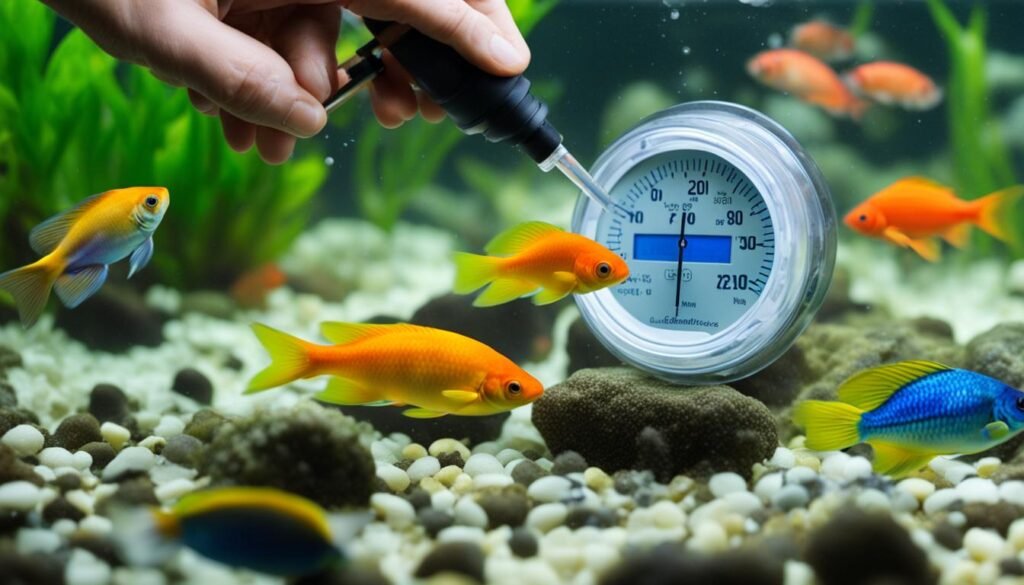Your cart is currently empty!

Is 8.2 pH Too High For an Aquarium?
Greetings fellow aquarium enthusiasts! Today, we dive into the world of pH levels in aquariums and explore the question, is 8.2 pH too high for an aquarium? Maintaining optimal pH levels is crucial for the health and well-being of our aquatic friends, so let’s get to the bottom of this pH predicament.
Key Takeaways:
- A pH level of 8.2 is not too high for an aquarium.
- Many fish species can thrive in slightly alkaline water.
- Research the specific pH requirements of your fish species.
- Maintain a stable pH level within the ideal range.
- Regularly monitor and adjust pH as needed.
Understanding pH in an Aquarium
In an aquarium, maintaining the right pH balance is crucial for the health and well-being of the aquatic life. pH, which stands for potential hydrogen, is a measure of the acidity or alkalinity of the water. It is represented on a scale from 0 to 14, with 7 being a neutral pH. pH levels below 7 indicate acidity, while levels above 7 indicate alkalinity. The ideal pH range for most fish species in an aquarium is between 6.5 and 7.5, although some hardy species can tolerate a pH of 8.2.
It’s important to note that different fish species have different pH preferences, as they have evolved to thrive in specific environmental conditions. Some may be more suited to slightly acidic water, while others prefer slightly alkaline water. Therefore, it is essential to research the specific pH requirements of the fish you are keeping to ensure their optimal health and longevity.
pH Levels and Fish Health
The pH level of the aquarium water directly impacts the overall health and well-being of the fish. Fish have a delicate internal pH balance, and drastic fluctuations or prolonged exposure to unfavorable pH levels can lead to stress, disease, and even death. When the pH deviates from a fish’s preferred range, it can affect their ability to breathe, disrupt their internal organs, and weaken their immune system, making them more susceptible to infections and parasites.
Additionally, pH levels can also affect the effectiveness of certain medications and the behavior of beneficial bacteria in the aquarium. Therefore, maintaining a stable pH within the recommended range is crucial for the overall health and vitality of the aquatic life in your aquarium.
pH Balance in the Aquarium
There are several factors that can affect the pH balance in an aquarium. These include the presence of naturally occurring minerals in the water, the decomposition of organic matter, the biological filtration process, and the use of certain aquarium additives or medications.
To maintain a healthy pH balance, regular monitoring of pH levels is essential. This can be done using commercially available test kits specifically designed for aquarium use. If adjustments are necessary, it is recommended to do so slowly and gradually to avoid shocking the fish. It’s important to note that sudden and drastic pH changes can be more harmful to fish than consistently high or low pH levels within the acceptable range.
By understanding pH levels in an aquarium and their impact on fish health, you can create a suitable environment for your aquatic pets, promoting their well-being and longevity.
Effects of High pH in an Aquarium
High pH levels in an aquarium can have harmful effects on the fish and other organisms living in the tank. It disrupts the delicate balance of their physiological functions, making it challenging for them to survive and thrive. Fish are highly sensitive to changes in pH, and an excessively high pH can lead to stress, reduced immune function, and even death.
One of the primary effects of high pH is its impact on fish physiology. High pH levels can interfere with the osmoregulation process, which is crucial for maintaining the internal balance of water and solutes in the fish’s body. This disruption can cause dehydration, electrolyte imbalances, and ultimately, organ failure. Fish may exhibit symptoms such as lethargy, loss of appetite, erratic swimming patterns, and increased vulnerability to diseases and infections.
Effects on Other Organisms
It’s not just fish that are affected by high pH in the aquarium. Other organisms such as plants, bacteria, and invertebrates also rely on a stable pH level for their well-being. High pH can inhibit the growth of beneficial bacteria, which are essential for maintaining water quality and breaking down harmful substances. Additionally, high pH can negatively impact plants by limiting their ability to absorb nutrients, leading to stunted growth and yellowing leaves.
Preventing and Addressing High pH
To prevent the harmful effects of high pH in an aquarium, it is crucial to regularly monitor and maintain the pH within the appropriate range. Testing the water regularly using a reliable pH test kit is essential to identify any imbalances. If the pH is consistently high, there are several steps you can take to address the issue.
- Perform partial water changes using water that has a lower pH to help dilute the alkalinity.
- Use pH-lowering additives specifically designed for aquarium use, following the manufacturer’s instructions carefully.
- Consider adding natural substances such as driftwood, peat moss, or almond leaves, which can release tannins that help lower pH.
It is important to note that when adjusting pH, gradual changes are recommended to avoid shocking the fish and other inhabitants of the aquarium. Sudden and drastic fluctuations in pH can be more harmful than a moderately high pH. Regular monitoring and careful adjustments will help create a stable and healthy environment for your aquatic pets.
Factors Contributing to High pH in an Aquarium

When it comes to maintaining the ideal pH level in your aquarium, there are several factors that can contribute to high pH. Understanding these factors is crucial for creating a healthy environment for your fish. Here are some key contributors to high pH in fish tanks:
- Mineral Buildup: Over time, minerals such as calcium and magnesium can accumulate in the aquarium water, leading to an increase in pH. This buildup can occur from sources such as tap water, substrate, or decorations. Regular water testing and monitoring can help identify and address mineral buildup.
- Inadequate Filtration: Insufficient filtration can result in the accumulation of organic matter in the aquarium water. This organic matter can contribute to high pH levels by producing waste products that increase the water’s alkalinity. Ensuring proper filtration and regular maintenance can help prevent the buildup of organic matter.
- Water Changes: Both infrequent and frequent water changes can impact the pH level in an aquarium. Infrequent water changes allow waste and uneaten food to accumulate, leading to high pH levels. Conversely, excessively frequent water changes can disrupt the balance of beneficial bacteria and result in a rise in pH. It’s essential to establish a balanced water change routine to maintain a stable pH.
Additionally, the overstocking of fish in a tank can also contribute to high pH levels. The increased fish population leads to more waste production and higher ammonia levels, which can raise the pH of the aquarium water. Ensuring proper stocking levels and avoiding overcrowding can help prevent pH imbalances.
By addressing these factors and implementing appropriate measures, you can maintain a healthy pH level in your aquarium and provide a suitable habitat for your fish.
Preventing High pH in an Aquarium

Maintaining a stable pH in your fish tank is crucial for the overall health and well-being of your aquatic inhabitants. Here are some practical tips to prevent high pH levels in your aquarium:
Frequent Water Changes
Regular water changes are essential for maintaining optimal water quality and pH levels in your aquarium. By replacing a portion of the water on a consistent schedule, you can dilute any accumulated minerals or chemicals that might contribute to high pH. Aim to change about 20% of the water every one to two weeks to keep the pH in check.
Proper Filtration and Maintenance
Adequate filtration is crucial for removing excess organic matter and waste from the tank. This helps prevent the buildup of ammonia and other compounds that can affect pH levels. Make sure to clean or replace filter media regularly to ensure optimal filtration efficiency. Additionally, regularly siphon the substrate to remove any debris that might contribute to high pH.
Monitor Mineral and Chemical Buildup
- Test your aquarium water regularly for mineral and chemical levels, especially if you notice a consistent increase in pH.
- If you detect high levels of minerals or chemicals, such as carbonates or bicarbonates, consider using reverse osmosis (RO) water for water changes or adding a pH stabilizer to maintain a healthy pH range.
- Be cautious with any chemicals or additives you introduce to your aquarium, as they can potentially affect pH levels if used incorrectly.
By following these preventive measures, you can help keep your aquarium’s pH within a healthy range, providing a suitable environment for your fish and other aquatic inhabitants.
Lowering High pH in an Aquarium

If you find that the pH in your aquarium is too high, don’t worry, there are several natural methods you can try to lower it. These methods are safe and effective in creating a more suitable environment for your fish.
1. Driftwood, Peat Moss, or Almond Leaves
Adding driftwood, peat moss, or almond leaves to your aquarium can release tannins into the water, which naturally lowers the pH. These items can be purchased from aquarium stores or online. Simply place them in your tank and allow them to leach tannins over time.
2. Reverse Osmosis (RO) Water
Using reverse osmosis (RO) water for water changes can help lower the pH in your aquarium. RO water has a low mineral content, which can help balance out the pH levels. You can purchase RO water from a local fish store or invest in a RO water filtration system for your home.
3. pH-Lowering Substances
If the above methods are not sufficient, you can consider adding pH-lowering substances to your aquarium. Sulfur is an effective option that can be added in small amounts. However, it is crucial to be cautious with the dosage and closely monitor the pH levels to avoid sudden and drastic changes.
By implementing these natural methods, you can gradually lower the pH in your aquarium and create a healthier environment for your fish. Remember to monitor the pH levels regularly and make adjustments as needed to maintain a stable and optimal range for your aquatic inhabitants.
Maintaining a Healthy pH Range for Aquarium Water

When it comes to maintaining an aquarium, one of the most important factors to consider is the pH level of the water. The pH level is a measure of the acidity or alkalinity of the water and can have a significant impact on the health and well-being of your aquatic inhabitants. To ensure a healthy environment for your fish, it is essential to maintain a pH range that is ideal for their specific needs.
The Ideal pH Range
The ideal pH range for aquarium water can vary depending on the species of fish you are keeping. It is crucial to research the specific pH preferences of your fish to determine the optimal range. Generally, most freshwater fish thrive in a pH range of 6.5 to 7.5. However, there are exceptions, such as African cichlids, which prefer a slightly higher pH of around 8.2. It is important to note that sudden and drastic changes in pH can be harmful to your fish, so it is best to aim for a stable pH within the ideal range.
Testing and Adjusting pH
To maintain a healthy pH range in your aquarium, regular testing is essential. There are various pH testing kits available that allow you to monitor the pH level accurately. Testing should be done weekly or bi-weekly, depending on the requirements of your fish species. If the pH level falls outside the ideal range, adjustments may be necessary. Adding pH buffers or conditioners specifically designed to raise or lower pH can help bring it back into the desired range. However, it is crucial to follow the instructions carefully and make gradual adjustments to avoid shocking the fish.
- Test the pH of your aquarium water regularly using a reliable pH testing kit.
- If the pH is outside the ideal range, make gradual adjustments using pH buffers or conditioners.
- Monitor the pH closely after making adjustments to ensure it remains stable within the desired range.
By maintaining a healthy pH range in your aquarium, you can provide a stable and suitable environment for your fish to thrive. Regular testing and adjustments, when necessary, will help ensure the well-being of your aquatic inhabitants.
Monitor Fish Behavior and Adjust as Needed

Monitoring fish behavior is essential for ensuring the water quality and overall health of your aquarium. By observing how your fish behave, you can detect any potential issues with pH levels and take prompt action to adjust them. Here are some key points to keep in mind when monitoring fish behavior and making necessary adjustments:
1. Observe Daily Patterns
Take note of the normal behavior patterns of your fish. They should be active, swimming freely, and interacting with their environment. Any sudden changes in behavior, such as lethargy, loss of appetite, or aggression, may be indicators of water quality problems, including high pH levels. If you notice these changes, it’s important to investigate further and determine if pH adjustments are needed.
2. Look for Physical Signs of Stress
Monitor your fish closely for any physical signs of stress. These may include fin clamping, rapid gill movement, excessive mucus production, or changes in coloration. High pH levels can cause discomfort and stress to fish, leading to these visible signs. If you observe any of these symptoms, it’s crucial to address the pH imbalance promptly.
3. Test pH Regularly
Regularly test the pH level of your aquarium water using a reliable test kit. This will give you accurate information about the current pH level and help you determine if adjustments are necessary. Aim to keep the pH within the appropriate range for your fish species, and make gradual adjustments if needed to avoid sudden fluctuations that can be stressful for the fish.
By monitoring fish behavior and being proactive in adjusting pH levels as needed, you can create a healthy and thriving environment for your aquarium inhabitants. Remember to prioritize the well-being of your fish by maintaining stable pH levels and addressing any issues promptly.
Conclusion
In conclusion, maintaining optimal pH in an aquarium is crucial for the well-being of our aquatic friends. While a pH level of 8.2 is not too high for many fish species, it is vital to research the specific pH requirements of the fish we are keeping. By understanding the factors that contribute to high pH levels and taking necessary precautions, we can ensure a healthy and thriving aquarium environment.
Regularly monitoring the pH level of our aquarium water and making adjustments when needed is key. By establishing a balanced water change routine, ensuring proper filtration and maintenance, and monitoring for mineral or chemical buildup, we can prevent unwanted fluctuations in pH. It is important to maintain a stable pH within the ideal range for the specific fish species we have in our aquarium.
Remember that our fish’s behavior can provide valuable insights into water quality and pH levels. If we observe abnormal behavior or signs of stress, it may indicate the need for pH adjustments or other modifications. By being proactive and attentive, we can create a suitable environment that promotes the health and well-being of our beloved underwater companions.
FAQ
Is a pH level of 8.2 too high for an aquarium?
No, a pH level of 8.2 is not too high for an aquarium. Many fish species can thrive in slightly alkaline water with a pH of 8.2.
Why is pH important in an aquarium?
pH is a measure of acidity or alkalinity in water. It is important to monitor and maintain a stable pH level in an aquarium to ensure the well-being of fish and other aquatic organisms.
What are the effects of high pH in an aquarium?
High pH levels can disrupt fish physiology, make it difficult for them to survive, and negatively impact plants, bacteria, and other aquatic organisms.
What factors contribute to high pH in an aquarium?
Factors such as infrequent or frequent water changes, mineral or chemical buildup, inadequate filtration, and overstocking fish can contribute to high pH levels in an aquarium.
How can I prevent high pH in an aquarium?
To prevent high pH, establish a balanced water change routine, ensure proper filtration and maintenance, and monitor mineral or chemical buildup.
How can I lower high pH in an aquarium?
You can try using natural methods like driftwood, peat moss, or almond leaves, using reverse osmosis (RO) water, or adding pH-lowering substances like sulfur. It is important to monitor pH closely and avoid sudden and drastic changes.
How do I maintain a healthy pH range for aquarium water?
Research and understand the ideal pH range for the specific fish species you are keeping, regularly test the pH level of the aquarium water, and make necessary adjustments to maintain a stable pH.
How can I monitor fish behavior for water quality and adjust as needed?
Observe your fish for abnormal behavior or signs of stress, which may indicate the need for pH adjustments or other parameter modifications in the aquarium.
Leave a Reply